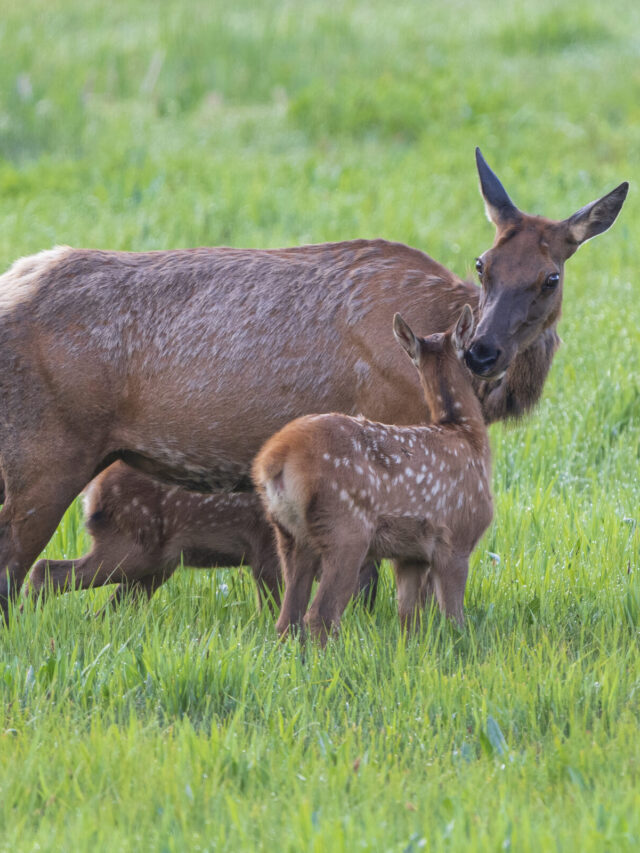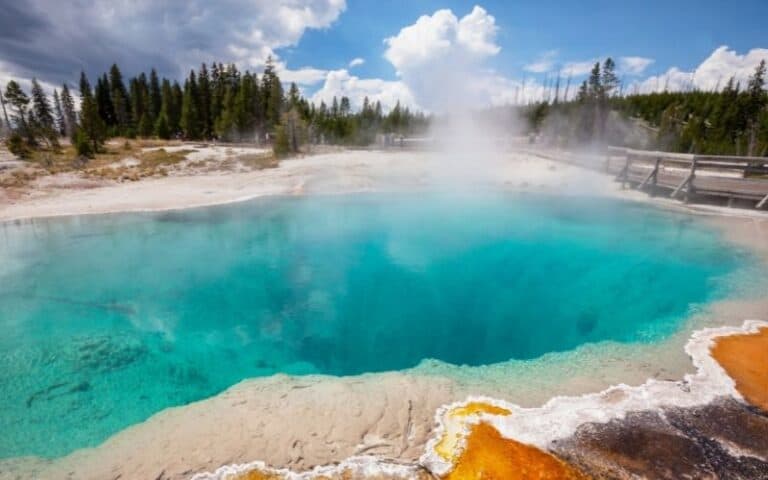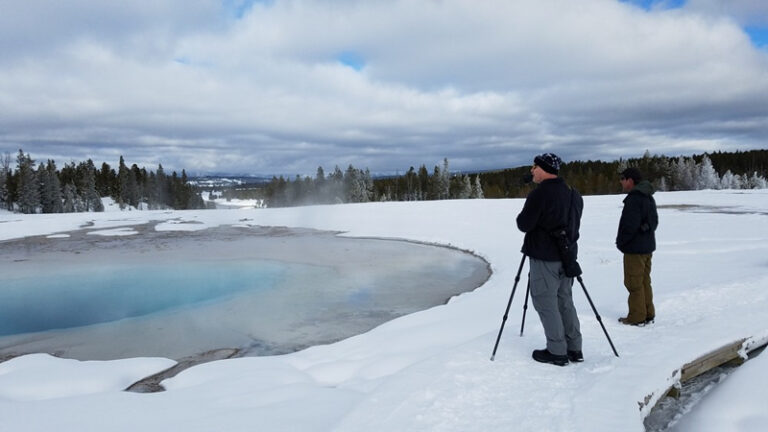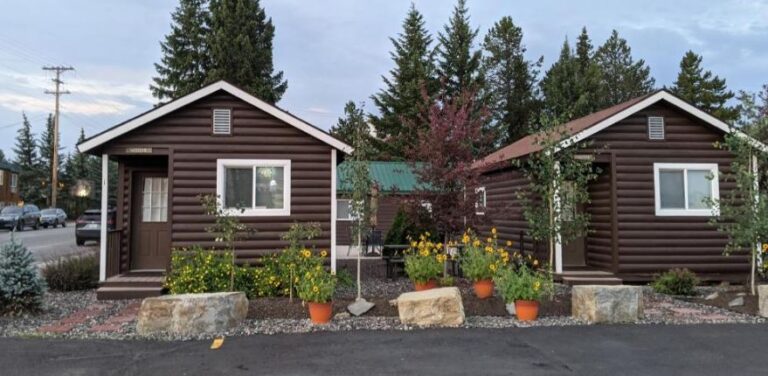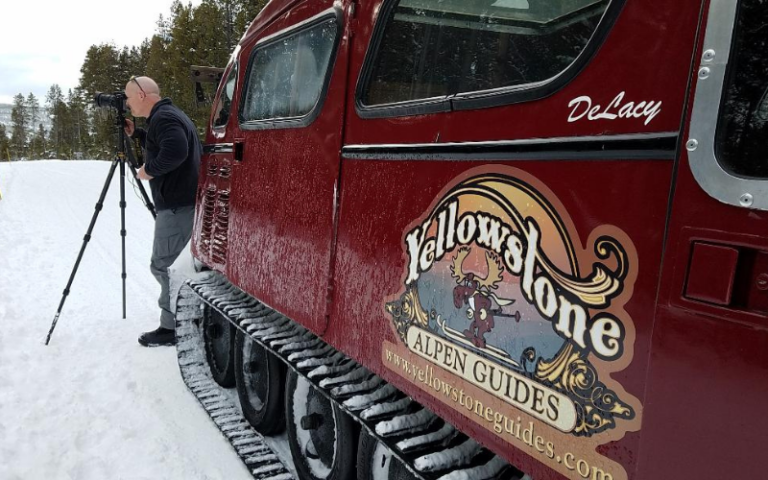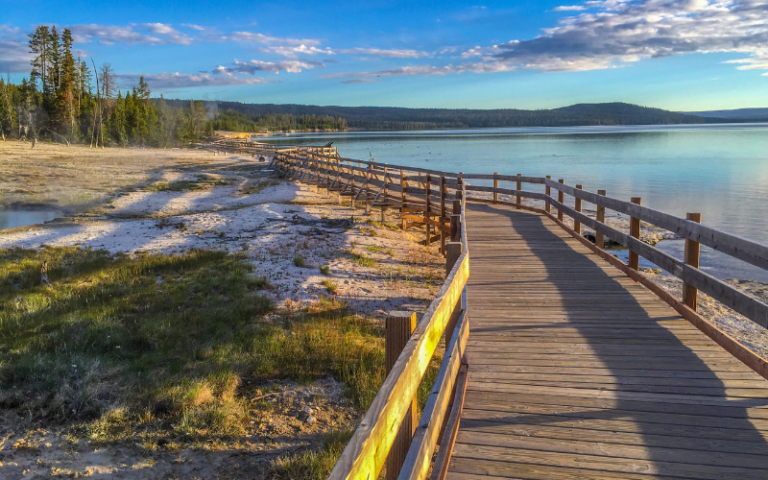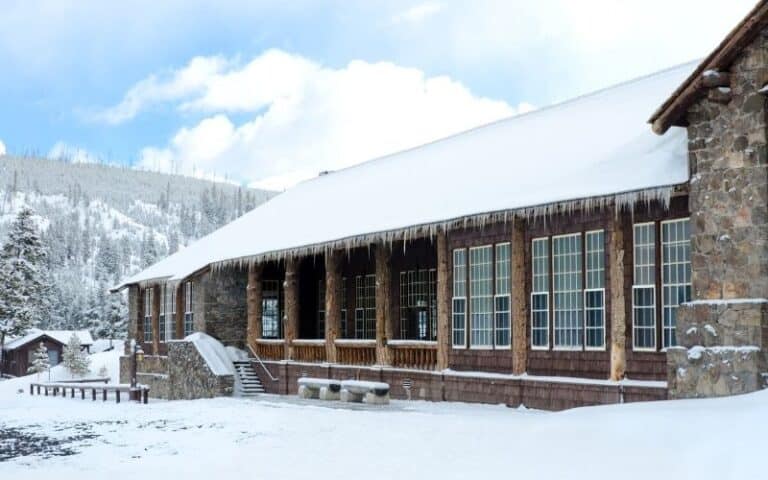Yellowstone National Park Spring Activities
Here’s a list of our favorite Yellowstone National Park spring activities plus travel tips for exploring this stunning park!
Use this Yellowstone National Park travel guide to plan an amazing itinerary full of fun spring activities! We also share tips for things to pack, where to stay and more!
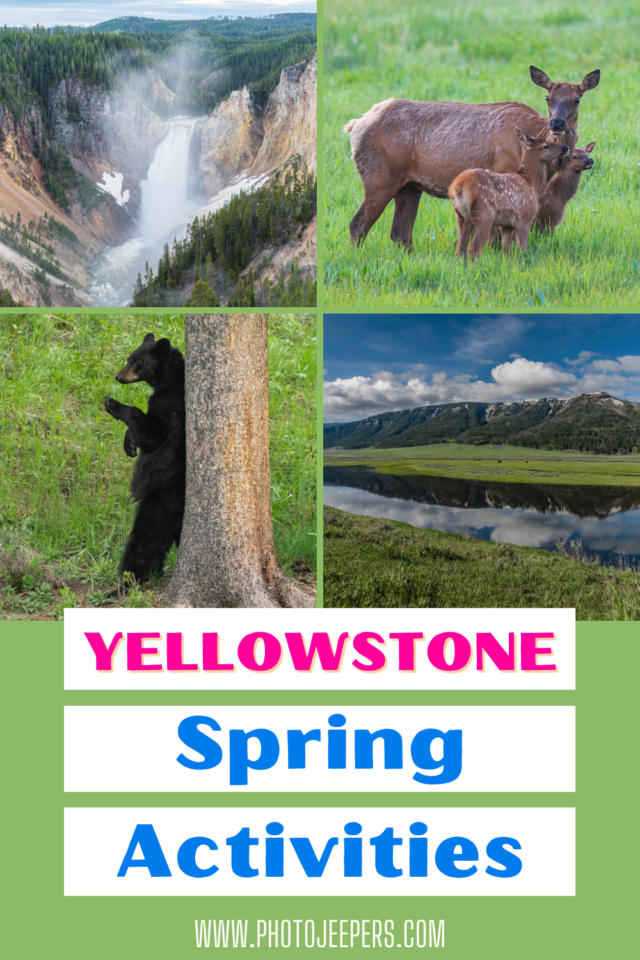
Usually from mid-March to mid-April all Yellowstone roads are closed to prepare them for vehicle travel. The road from Gardiner in the North to Cooke City in the Northeast is open all year.
Yellowstone in the spring can often feel more like winter. It’s not until late spring when you can explore the park’s scenic drives, hiking, wildlife-viewing, and photography.
This site contains affiliate links which means WE may receive commissions for purchases made through these links. We only provide links to products we actually use and/or wholeheartedly recommend! As an Amazon Associate, we earn from qualifying purchases. Read the full Disclosure Policy.
Yellowstone National Park in the Spring
It’s important to know the Yellowstone National Park weather for the times you’ll visit in the spring. Temperatures throughout the day can range from the 30s to the 60s Fahrenheit. The nights are still well below freezing near the teens or single digits.
If you’re Yellowstone National Park packing list doesn’t include right clothing for the conditions, then you won’t enjoy outdoor activities! The weather can change almost instantly so you want to be sure you come prepared with the right clothes especially for those very cold days and nights.
When visiting Yellowstone in the Spring, pay attention to winter closing dates and spring opening dates. Check the NPS website for updated Yellowstone road status.
Yellowstone National Park Spring Activities
Here’s a list of the Yellowstone National Park activities you can do in the spring!
Visitor Centers the Spring at Yellowstone
We recommend visiting the various Visitor Centers in the park to get updated information on the points of interest, hiking trails, and other activities to do in each area.
- Old Faithful Visitor Education Center – open daily between April and early November)
- Canyon Visitor Education Center – open daily between May and mid-October)
- Fishing Bridge Museum and Visitor Center – open daily between late May and late September
- Grant Village Visitor Center – open daily between late May and late September
- Madison Information Station – open daily between late May and late September
- Albright Visitor Center at Mammoth – open daily, year-round at Mammoth Hot Springs
- Norris Area Museums – The Norris Geyser Basin Museum and the Museum of the National Park Ranger are open daily between late May and late September
- West Yellowstone Visitor Information Center – open daily, year-round and located in the town of West Yellowstone
Many of these visitor centers also contain park stores that sell a variety of different souvenirs: books, artwork, and educational materials.
Spring Biking at Yellowstone
Biking in the spring is a popular activity to get around the park once roads are cleared and the park determines that they are “open” for bike riders. This usually happens towards the end of March.
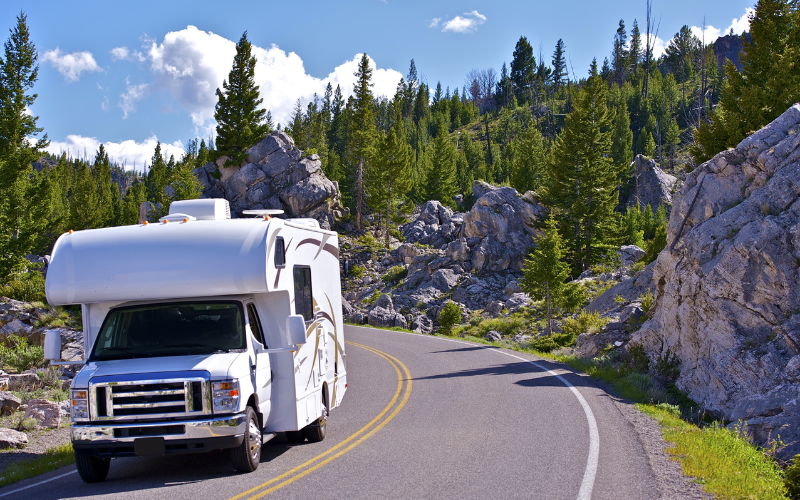
Spring Scenic Drives in Yellowstone
Mid-April the West Entrance road opens so you can drive to Madison, Mammoth, Old Faithful, Norris and Canyon. By mid-May all the rest of the park roads are open so you can all of the beautiful Yellowstone scenic drives.
You’ll find the most crowds along the Yellowstone National Park Southern Loop. There are three entrances to access the southern loop of Yellowstone: West (West Yellowstone), South (Grand Teton), and East (Cody):
- Madison
- Old Faithful
- Lake
- West Thumb Geyser Basin
- Grant Village
- Canyon
- Norris
There are two entrances with direct access to the Yellowstone National Park Northern Loop: North (Gardiner) and Northeast (Cooke City).
There are four areas in the northern loop of Yellowstone:
- Mammoth
- Tower-Roosevelt
- Lamar Valley
- Canyon
- Norris
If you are looking to drive through Yellowstone yourself, but want to hear all the fun and educational information about this National Park, we recommend the the GyPSy App Guide. It will automatically tell you stories, tips and directions as you drive that will help enrich your Yellowstone National Park experience. There’s no need for cell service or wifi signal while touring. Tours are downloaded to your device for easy offline use.
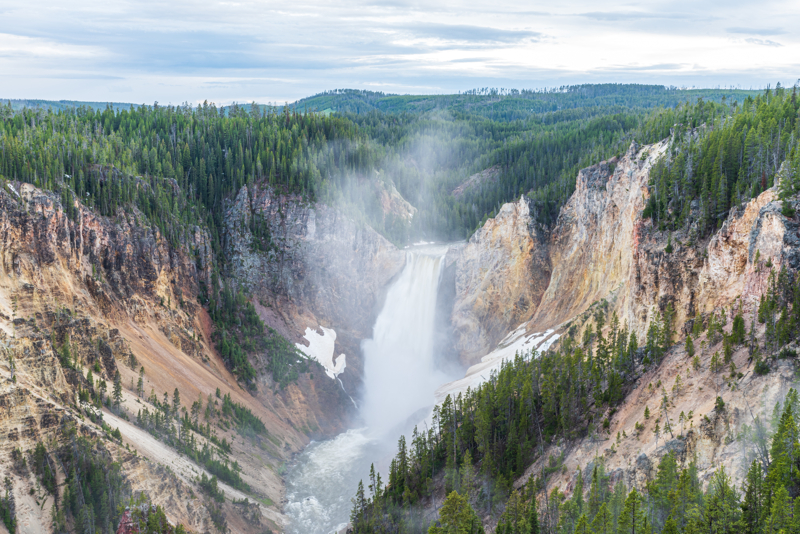
Spring Hiking in Yellowstone
Early spring most of the Yellowstone hiking trails are still wet and muddy – many of them stay this way until early July! By May, the lower elevation hiking trails are usually cleared and ready for you to explore!
Spring means bear activity and some areas may be closed for bear management. Be sure to carry bear spray and be alert!!
Here are some tips for hiking in the spring at Yellowstone:
- Check with the rangers at the Visitor Center to get current trail conditions.
- Tell someone your hiking destination, route, and estimated time of return.
- What to Bring on a Day Hike: hydration pack, raincoat, warm hat, fleece jacket, insect repellent, sunscreen, and a first aid kit.
- Stay on trails: taking shortcuts causes trail erosion and is dangerous. In hydrothermal areas, stepping on thin crust may plunge you into boiling water.
Here’s a list of hikes in Yellowstone by region:
- Mammoth Hot Springs Area Day Hikes
- Old Faithful Area Day Hikes
- Canyon Area Day Hikes
- Madison
- Lake and Fishing Bridge Area Day Hikes
- Tower and Northeast
- West Thumb and Grant
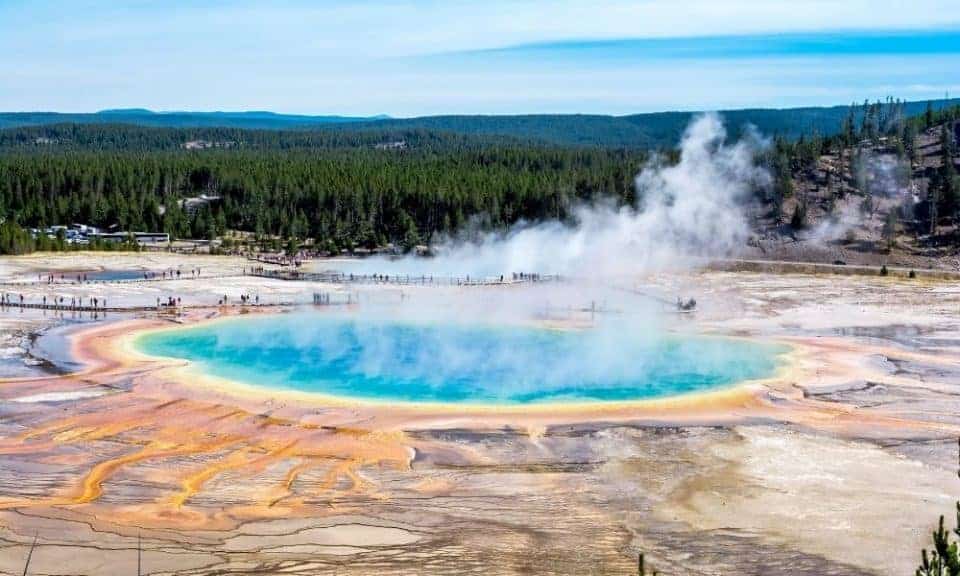
Geysers and Hot Springs in Yellowstone
There are five types of hydrothermal features you’ll see in Yellowstone: geysers, hot springs, mudpots, travertine terraces and fumaroles. Check out the NPS website for the latest geyser eruption predictions!
Here’s a list of the best places to see these wonders:
- Old Faithful, Upper and Lower Geyser Basin
- Grand Prismatic (Midway Geyser Basin)
- Norris Geyser Basin
- West Thumb Geyser Basin
- Mud Volcano
- Fountain Paint Pot
- Mammoth Hot Springs
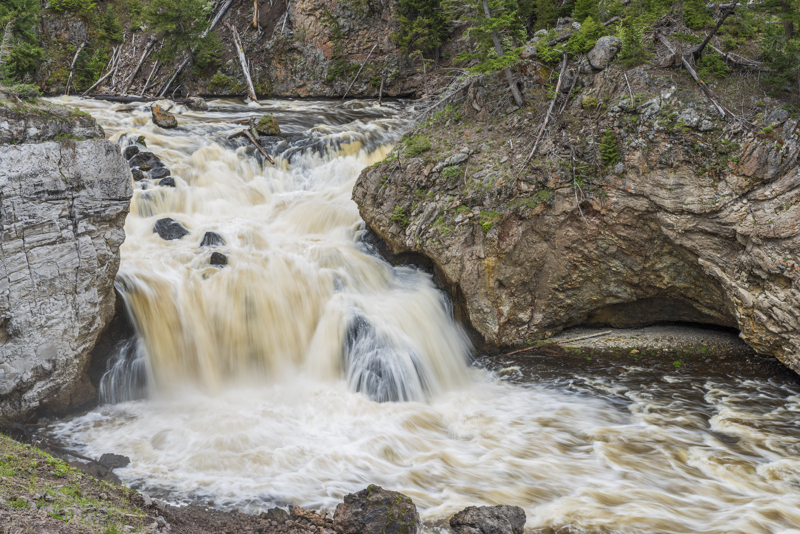
Waterfalls in the Spring at Yellowstone
Most of the Yellowstone waterfalls don’t require hiking to see them. In the spring the water is running high so it’s a good time to photograph waterfalls.
Here’s a list of the main waterfall attractions:
- Canyon: Lower and Upper Falls, Brink of Upper Falls
- Firehole Falls
- Gibbon Falls
- Kepler Cascades
- Lewis Falls
- Moose Falls
- Tower Fall
- Undine Falls
Wildlife in the Spring at Yellowstone
Animals can be found throughout the park at any time. Check out our detailed guide for the best places to see Wildlife in Yellowstone National Park!
We find late spring is one of the best times to visit yellowstone for wildlife!
March – male bears begin to emerge from their dens searching for carcasses. Bison once again return to the Blacktail Ponds area. Sandhill cranes, ducks, robins, swans, geese, red-tailed hawks, bluebirds, and meadowlarks also begin to return to Yellowstone this time of year.
April – you’ll begin to see bison calves along the northern end of the park. These calves are also called ‘red dogs’ because of their bright rusty orange coats. Male bears are also out and about. More birds begin to return: warblers, flycatchers, tanagers, swallows, loons, peregrine falcons, and osprey.
May – it’s an amazing time for wildlife babies: bear cubs, elk calves, and wolf pups begin to be seen throughout the park in the vibrant green meadows.
Remember the parameters to keep you and the animals safe!
- Never approach animals. The animals in Yellowstone are wild and unpredictable, no matter how calm they appear to be.
- The safest (and often best) view of wildlife is from inside a car. Always stay at least 100 yards (91 m) away from bears and wolves, and at least 25 yards (23 m) away from all other animals, including bison and elk. You may need to use a spotting scope to see wildlife in Yellowstone.
- Never feed wildlife. Animals that become dependent on human food may become aggressive toward people and have to be killed. Keep all food, garbage, or other smelly items packed away when not in use.
- Never park in the road or block traffic. Use pullouts to watch wildlife and let other cars pass. Stay with your vehicle if you encounter a wildlife jam.
Here’s a list of camera gear we recommend if you’re serious about photographing wildlife at Yellowstone.
- Best cameras for wildlife photography
- Best tripods for wildlife photography
- Best lenses for wildlife photography
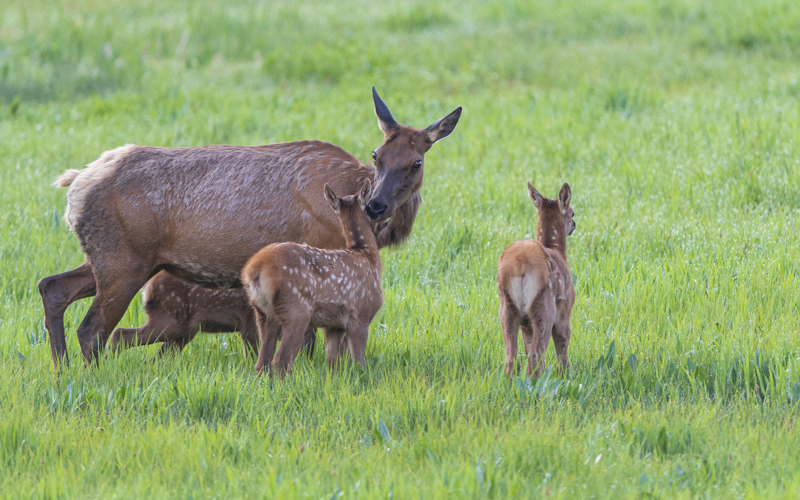
Spring Photography in Yellowstone
We recommend you have your camera ready to go because the wildlife you may see as you drive through the park won’t wait for you to find the camera in your car.
You’ll also want to photograph the geysers, hot pools, waterfalls and rivers. Here are some tips for taking pictures at Yellowstone.
- Tips for Photographing Wildlife
- How to Photograph Waterfalls and Rivers
- How to Photograph Reflections
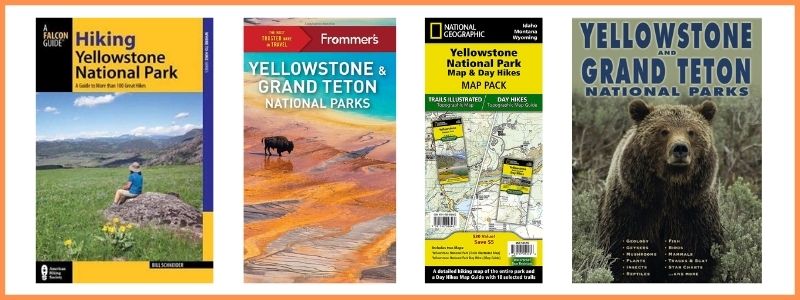
Where to Stay Near Yellowstone
Places to stay in West Yellowstone
- Holiday Inn, West Yellowstone
- ClubHouse Inn, West Yellowstone
- Kelly Inn, West Yellowstone
- West Yellowstone hotels!
Places to stay in Gardiner
- Yellowstone Gateway Inn, Gardiner – full kitchen and comfy bed, one of our favorite places to stay!
- Park Hotel Yellowstone, Gardiner – charming place to stay and loved by guests!
- Absaroka Lodge, Gardiner – beautiful location with river views!
- Gardiner hotels!
Places to stay in Cooke City or Silver Gate
- Sunny Log Home on the Creek, Silver Gate (VRBO) – the most AMAZING location with an awesome fireplace and comfy bed!
- High Country Motel and Cabins – local owners who love what they do, and make you feel so welcome!



